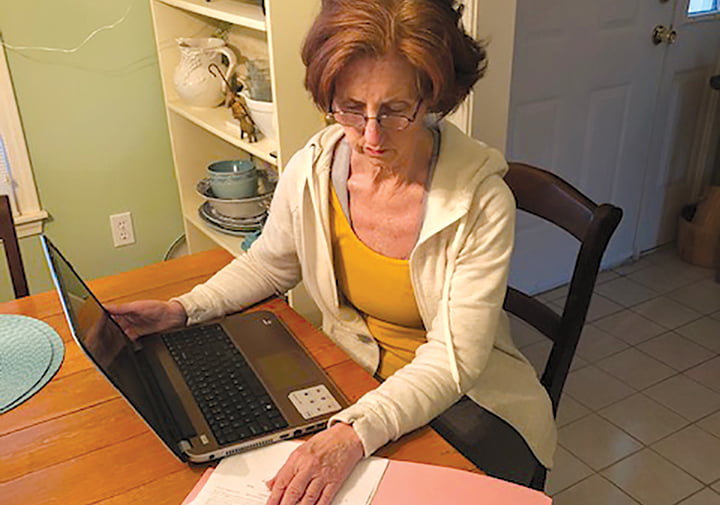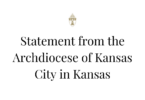
by Joe Bollig
joe.bollig@theleaven.org
KANSAS CITY, Kan. — “Stay at home” orders and social distancing are putting the brakes on the spread of the coronavirus pandemic, but they’re also slowing the economy — and hurting people.
Businesses are struggling to meet expenses as revenues disappear, forcing them to lay off or furlough employees. During a two-week period from late March to early April, a record 10 million people applied for unemployment benefits.
Catholic parishes, schools and other entities are getting hit, too.
In normal circumstances, people go to church every week and drop their contribution in the collection basket, said Carla Mills, chief financial officer of the Archdiocese of Kansas City in Kansas.
“Then, all of a sudden and in a very short period of time, people can’t drop their envelope in the collection basket. And if they’re not set up for electronic giving, the church’s income is cut drastically,” said Mills.
There is cause for hope in this grim scenario, she said.
On March 27, the U.S. Congress passed and President Donald Trump signed the $2.2 trillion Coronavirus Aid Relief and Economic Security Act — or CARES Act.
This, the largest financial support package in the history of the United States, has several components. One of them is the Paycheck Protection Program, a $349 billion loan program offered through the Small Business Administration.
The purpose of the PPP is to give relief to individuals and small businesses, giving them forgivable loans to keep employees on their payrolls.
Mills and archdiocesan employees in the human resources, accounting and finance offices have been working hard to encourage the 106 parishes, 42 schools and 22 other entities of the archdiocese to apply for the PPP loans.
“I think they have responded pretty well,” said Mills. “We’ve been communicating about the program vigorously.”
To understand the PPP at the parish level, The Leaven turned to Patty Dickinson, business manager at St. Patrick Parish in Kansas City, Kansas.
Q: Do Catholic parishes and schools qualify?
A: Yes. The PPP loan is intended to help employers to keep employees on the payroll for an eight-week period. Since Catholic parishes are considered nonprofit, 501(c)(3) religious organizations, they should seriously consider applying for the PPP loan.
Q: Why should they apply?
A: The loan will help a parish or organization cover payroll costs, and 25% of the loan can be used for other expenses, including mortgage, rent and utility payments.
Q: How do parishes benefit?
A: If your parish needs help with payroll, mortgage, rent or utility expenses as contributions decline, you should apply. The benefit is that loan proceeds used for payroll are forgivable if you meet employment guidelines.
Q: What amount should be applied for?
A: Employers applying for the loan are eligible for two times their average monthly payroll and an additional 25% of that amount. Most banks require a monthly spreadsheet to be completed that will calculate your average monthly payroll. This spreadsheet will require payroll detail from both Paylocity and Dayforce payroll registers or, for small parishes, from your past payroll registers.
Q: Where do you start?
A: Step one, start by accessing the information about the PPP from the U.S. Treasury website at: home.treasury.gov (click on the red banner, “For small businesses seeking relief from COVID-19”). Step two, contact your bank. If your bank is associated with the Small Business Administration, it should be able to help you. The bank can email the documentation required to be completed and is the final answer on questions.
Q: When will the loans be given?
A: The sooner a parish submits the application the better, but you need to be thorough and accurate. You might get questions from underwriting as your loan is processed, or you may be audited later. Your bank is your contact, but the SBA and U.S. Treasury will approve the loans. Banks haven’t said when the loans will be issued, but the government knows the loans are needed immediately. The application period is from April 3 to June 30 for the initial funds.
Q: What must the loans be used for?
A: First, for payroll. Loan funds spent on payroll are forgivable. Second, for mortgage, rent, utilities — up to 25% of the payroll loan amount is available for these costs. (Be sure to read the details on what qualifies.)
Q: Must the loans be repaid?
A: Some loans can be forgiven. Loan forgiveness is reduced or disallowed, however, if:
• More than 25% of the loan is spent on rent, mortgage, utilities
• You reduce your employee full-time equivalents
• You decrease salary and wages by more than 25% for any employee who made less than $100,000 annualized in 2019
Q: What is a full-time equivalent?
A: The process of counting full-time and part-time employees is somewhat involved. Simply put, you can put two half-time employees together for one full-time equivalent. For detailed instructions on how to count employees, go online to: home.treasury.gov.
Q: If a pastor or parish business manager has further questions, who is available at the Catholic Church Offices to help them?
A: If you have any questions about the process, contact Carla Mills by email at: cmills@archkck.org. She can help walk you through it.






